1. Introduction
 XFX is one of nVidia’s favourite manufacturers. It holds one of the top sales position world-wide, keeping prices considerably low and making nVidia even happier. For a long time, we expected to see a low-end VGA card from the GeForce7 series … but instead, out comes the 6800GS.
XFX is one of nVidia’s favourite manufacturers. It holds one of the top sales position world-wide, keeping prices considerably low and making nVidia even happier. For a long time, we expected to see a low-end VGA card from the GeForce7 series … but instead, out comes the 6800GS.
Although it sounds a little strange that nVidia still supports the GeForce6 series, it is indeed a very smart marketing move. It covers the needs of middle of the range users, those who like to play all the games but not necessarily at the highest quality, or those who just don’t have that much money to spend on a 7800GT card.
The 6800GS comes to replace the good old 6800GT. Although the performance of the new GS model must be more or less the same, there are some major differences between these two cards.

In this review we will be testing the XFX 6800GS XXX Edition VGA card. This is the highest stock overclocked 6800GS card you can find on the market. There are AGP and PCI-E editions of this card. We received the PCI-E edition.
- Packaging/Bundle

In the retail box, you will find the usual stuff. A quick installation guide, a user's guide, FarCry, and the drivers disc. As with many other XFX cards, the retail box is "X" shaped, and everything is very well organized inside, making you wonder how all this stuff could fit in that box!

You will also find DVI to VGA adapters, a power adapter cord and a TV-out cable.

On the rear of the box, you will find the serial number and the card's fan cover.

You will also find "The Flames of Deception - Episode 02". And if you are wondering what this is, all you have to do is go to a store and read the story on the back of the box :-)
2. Features
As already mentioned, the 6800GS card comes in to replace the 6800GT card. But there are some major differences between these two cards. First of all, the GS model uses the new NV42 architecture, while the GT model used the NV40. This means that a whole different manufacturing architecture is embedded in the 6800GS card.
The old 6800GT operated with 16 pixels shader and 6 texture shader pipelines, but the new 6800GS runs with only 12 pixels shader and 5 texture shader pipelines. But even with reduced pixels shader and texture pipelines, the 6800GS still manages better performance than a 6800GT. The secret is hidden within the chipset architecture. The new chipset technologies and the higher clock rates leave more room for the card to show us its true value. According to nVidia: “the default running frequency for the new 6800GS card is 425MHz core clock and 500MHz memory clock”. We should remind you that the old 6800GT card was clocked at 350MHz (core clock) with the same running frequency for the memory clock. All these clocks apply to the standard reference 6800GS board and NOT to the XFX 6800GS XXX Edition. Read on to see what more the XFX has to offer.
- Key Features
 This is a groundbreaking new hardware technology that pushes 3D real-time graphics one step closer to film quality. It offers infinite length shader programs, dynamic flow control, displacement mapping, vertex frequency stream divider and Multiple Render Target (MRT) technology. Previously, highly complex effects were not possible without sacrificing
performance and precision, because of long shader programs that required many
computational passes. Now, with the CineFX 3.0
engine, groundbreaking effects can be created without compromising performance.
This is a groundbreaking new hardware technology that pushes 3D real-time graphics one step closer to film quality. It offers infinite length shader programs, dynamic flow control, displacement mapping, vertex frequency stream divider and Multiple Render Target (MRT) technology. Previously, highly complex effects were not possible without sacrificing
performance and precision, because of long shader programs that required many
computational passes. Now, with the CineFX 3.0
engine, groundbreaking effects can be created without compromising performance.

The NVIDIA nForce4 Scalable Link Interface (SLI) technology allows two graphics processing units in a single computer. This technology takes advantage of the PCI Express bus architecture and features intelligent hardware and software solutions that allows multiple GPUs to work together and achieve exceptional performance.
- UltraShadow II
More photo-realistic scenes and environments in your games, without compromising PC performance. Complicated lighting and shadow effects become practical and next-generation games rise to the next level in cinematic realism.
- Pixel Shader Model 3.0
Better performance and more realistic shades to produce high quality images within games.
- High-Speed GDDR3 memory interface
- NVIDIA High-Precision Dynamic-Range (HPDR) technology
NVIDIA
HPDR sets new standards for image clarity and quality through floating point
capabilities in shading, filtering, texturing, and blending.
- NVIDIA® Intellisample™ 3.0 technology
The industry's fastest anti-aliasing delivers ultra-realistic visuals, with no jagged edges, at lightning-fast speeds
- NVIDIA nVIEW Multi-display technology
Advanced technology provides the ultimate in viewing flexibility and control for multiple monitors.

- Specifications
The XFX 6800GS specifications, as given by XFX, are shown below:
| Engine Clock |
485MHz (vs standard at 425MHz) |
| Memory Clock |
1.1GHz (vs standard at 1GHz) |
| Chipset |
GeForce 6800 GS |
| Memory |
256 MB |
| Bus Type |
PCI-E |
| Memory Type |
DDR3 |
| Memory Bus |
256-bit |
| Output |
DVI |
| Highlighted Features |
TV Out , HDTV ready , SLI ready |
| Graphics Core |
256-bit |
| Memory Interface |
256-bit |
| Memory Bandwidth |
32 GB/sec |
| Vertices Per Second |
531 Million |
| Pixels per Clock (peak) |
12 |
| Textures per Pixel |
12 |
| RAMDACs |
400 MHz |
| Fill Rate |
5.1 Billion Texels/sec. |
| Memory Date Rate |
1000 MHz |
As you can see, the XFX 6800GS XXX Edition is overclocked even further. It runs at 485MHz core clock while the memory is clocked at 550MHz. It is very interesting to see how far we can go with the (stock overclocked) XFX 6800GS. We should also mention that there is also a 6800GS Extreme edition available on the market, that is clocked at 450MHz core clock and 525MHz (1.05GHz) memory clock.

3. A Closer look
The card layout might look familiar to 6800GT owners. The fan looks pretty cool with the XFX/nVidia animal cartoon. The fan’s rotation speed changes according to the temperature of the chipset, making the card even quieter when extra cooling is not necessary when running less graphics intensive applications.

The XFX 6800GS offers a DVI-I analog output, a standard VGA output and a TV-out S-Video connection.

On the back, you will find the standard PCI-E power connector and the usual array of capacitors and transistors.

Of course, the card is SLI compatible. That means, by adding a second 6800GS card, you can have even better performance.

4. Testbed
For this review, we used the latest 81.98 nVidia drivers, and we used our standard AMD based system.

- Processor: AMD64 3500+ NewCastle (939 socket)
- Case: Antec 1080AMG
- Motherboard: ASUS A8N-SLI Premium
- Memory: 2x512MB Corsair XMS TWINX1024-3200XL Memory
- Hard Disk Drive: WD800JD 80GB 7200RPM
- DVD Burner: Pioneer DVR-A08XLA
- Power Supply: EzCool 550Watt
- OS: Microsoft WindowsXP Pro SP2
- DirectX: v9.0c
- nVidia Display Drivers: 81.98

Benchmarking Software
3DMark05,03,01
Codecreatures Benchmark Pro
AquaMark3 v3.0
RivaTuner
Farcry v1.3
HL2
Ground Control II
NFS: Most Wanted
Quake4
F.E.A.R.
For comparison, we will be posting the results of the XFX 6800GS XXX Edition along with the results of the Club3D X1800XT and AOpen 7800GTX.
5. 3DMark05
 With 3DMark05, Futuremark continues the tradition in its benchmarking software by providing a state-of-the-art Microsoft ® DirectX ® 9 3D performance benchmark.
With 3DMark05, Futuremark continues the tradition in its benchmarking software by providing a state-of-the-art Microsoft ® DirectX ® 9 3D performance benchmark.
3DMark05 is an all new 3DMark version making the most of Microsoft's DirectX
9. The previous version 3DMark03, did a nice introduction into this level
of technology. However,
3DMark03 used DirectX 9 specific features in a limited manner, because fully
supporting hardware was rare at the time of its launch. In contrast, 3DMark05
requires DirectX 9 hardware with full support for at least Shader Model 2,
and takes shader usage to never before seen levels.
Just like its predecessors, 3DMark05's point system is set so that at the
moment of release, the high-end VGA cards available in stores can only score
around 5000 3DMarks, whereas the worst card that meets the programs requirements
yields a score of 1000.
Game Test 1 -Return to Proxycon
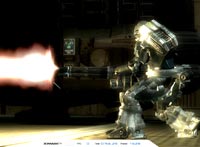 Being the sequel to the "Battle of Proxycon"
from 3DMark03, in "Return to Proxycon" we're once again set in space
and the battle continues as space pirates invade a cargo ship in order to
take control of its valuable cargo.
Being the sequel to the "Battle of Proxycon"
from 3DMark03, in "Return to Proxycon" we're once again set in space
and the battle continues as space pirates invade a cargo ship in order to
take control of its valuable cargo.
This test, tries to simulate a future first-person shooter game with all the high details that entails. The dynamic shadows, high-detailed environment and advanced lighting techniques ensure that under normal circumstances, no recent card can run it with decent frame rates.
Game Test 2 - Firefly Forest
 A forest gets filled with magic fireflies in the night. The moon is nearly full, illuminating the forest with a bluish faint light. The magic fireflies have flickering bright green lights that playfully move around the forest.
A forest gets filled with magic fireflies in the night. The moon is nearly full, illuminating the forest with a bluish faint light. The magic fireflies have flickering bright green lights that playfully move around the forest.
This scene is a nice example of a smaller scale outdoor scene with rich vegetation. Immediate visibility is not so far, and there is a skybox surrounding the whole scene.
A large number of trees with their branches swinging separately, and dense vegetation being dynamically distributed according to the camera movements, make this test the most demanding of the three.
Game Test 3 - Canyon Flight
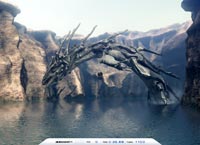 A Jules Verne type airship flies through a canyon guarded
by a dangerous sea monster. The airmen defend their ship using heavy cannons,
but these seem to have no effect on the huge sea monster. Finally the crew
manages a narrow escape using the "last resort" afterburners of
the airship.
A Jules Verne type airship flies through a canyon guarded
by a dangerous sea monster. The airmen defend their ship using heavy cannons,
but these seem to have no effect on the huge sea monster. Finally the crew
manages a narrow escape using the "last resort" afterburners of
the airship.
This scene is fairly complex with large areas of water
reflecting the high canyon walls. The water actually is one of the key points
of interest in this scene. The water not only does realistic looking reflections
and refractions, it has a depth fog, making the sea monster swimming under
the airship actually look deep down in the water. The air in this scene also
uses a volumetric fog, making distant cliffs of the canyon really look far
away.
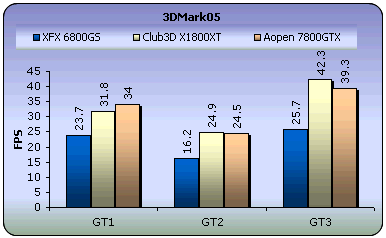
The 7800GTX and the ATI X1800XT are high-end cards and so the XFX 6800GS cannot compete with them. Of course, they also cost a few hundred dollars more. We chose to compare the XFX 6800GS with these cards because there were rumours that in many cases, the 6800GS chipset seems to be better than ATI's X1800XT boards. As you can see, the 3dMark05 benchmarking software does not confirm this.
Final Score
3DMarks on 3DMark05 are now calculated by the following formula:
(Game Test 1 * Game Test 2 * Game Test 3)^0.33 * 250
This is basically the geometric mean of the total frames in each
game multiplied by 250. This means that all game tests are now equal.
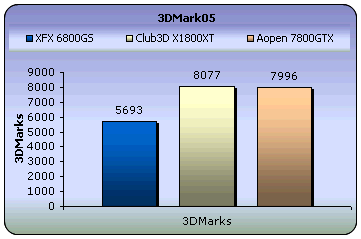
Since the 6800GS gave us the lowest framerates in all 3dMark05 games, is was expected that it would also get the lowest marks.
6. 3DMark03
 3D Mark is a widely used and accepted benchmark that stresses the DirectX performance of a VGA card. A very strong point of 3DMark is that it's VGA card measuring is does not require any CPU power. So the resulting fps are a good reference a VGA card's rendering performance. For testing the performance of each card we used the 4 game benchmarks 3DMark has.
3D Mark is a widely used and accepted benchmark that stresses the DirectX performance of a VGA card. A very strong point of 3DMark is that it's VGA card measuring is does not require any CPU power. So the resulting fps are a good reference a VGA card's rendering performance. For testing the performance of each card we used the 4 game benchmarks 3DMark has.
3Dmark03 also includes sound and CPU tests as well as some other feature tests.
- Game Test 1 - Wings of Fury (DX7)

This test is a combat flight simulator written for older hardware (DirectX 7). Particles are used a lot in this test - smoke and vapor trails, flak and gunfire, and explosions are produced using point sprites and quads.
- Game Test 2 - Battle of Proxycon (DX8)

This test is a simulation of first person shooter game types. 1.1 and 1.4 Vertex shaders are widely used since all character models are skinned using vertex shaders.This makes this test a good vertex shader comparison for VGA cards.
- Game Test 3 - Trolls' Lair (DX8)

This test should be the favorite of all RPG lovers. It is a cut scene of a female warrior facing two malicious trolls. Again the same vertex and pixel processing is used as in game test 2.
This test also uses post-processing effects, such as Depth of Field and Bloom effects which are widely used in today's game cut scene sequences.
- Game Test 4 - Mother Nature (DX9)

Mother nature represents the level of effects and realism that are possible using 2.0 vertex and pixel shaders, plus some other features that DirectX 9 offers.
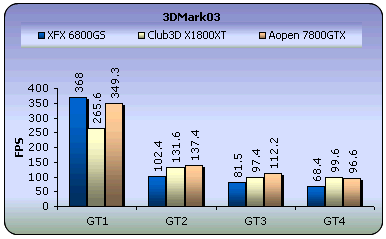
Want to see smoke and vapor trails, flak and gunfire? No problem. The XFX 6800GS XXX Edition performs even faster than the 7800GTX, to say nothing about the X1800XT that was left way behind. But this was only observed in the first game test, although it is a big deal for a mid-range card competing with the giants. David just killed Goliath? :-)
- 3DMark Official score
If you test your machine with 3DMark, you can post the results at 3DMark's online result browser. For more information visit futuremark.com.
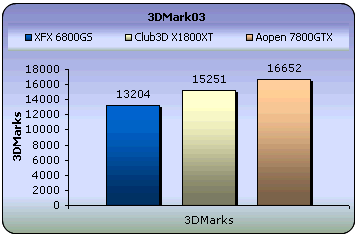
The 6800GS XXX performance was similar to that of the 6800Ultra cards. In this comparison though, performance in the other games was not as good as in the first. But again, the difference in performance does not justify the difference in money, with the 6800GS being much much cheaper than the other two cards.
7. Codecreatures
 CodeCreatures is a synthetic 3D benchmark that is a good reference for VGA performance comparison. This is a high-end 3D benchmark that also requires DirectX 8 hardware, making a good tool for measuring the potential of DirectX 8 game performance.
CodeCreatures is a synthetic 3D benchmark that is a good reference for VGA performance comparison. This is a high-end 3D benchmark that also requires DirectX 8 hardware, making a good tool for measuring the potential of DirectX 8 game performance.
The Codecreatures benchmark is written with Microsoft's DirectX 8.1 API and incorporates the use of Vertex and PixelShaders popular on next generation 3D accelerators.

The benchmark plays a photo-realistic nature scene and calculates the performance of the graphics adapter by measuring the fps that it can display at 1024x768, 1280x1024 and 1600x1200 resolutions.
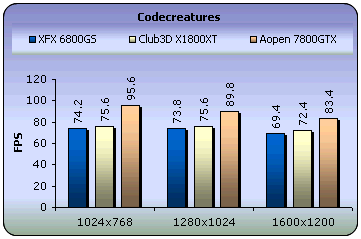
-Codecreatures number
The codecreatures number is the resulting score of the total
benchmarking process and is basically the geometric mean of the three frame
rates multiplied by 100.
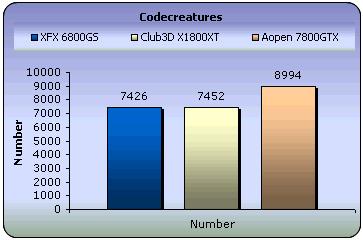
Excellent performance for a VGA card of this kind. The 6800GS XXX Edition really makes a difference in the mid-range arena, and although it could not quite surpass the X1800XT, it manages to get really close.
8. 3DMark01 / Aquamark
 Since the majority of today's applications and games are compatible with DirectX 9, the need of benchmark applications that use DX 9 has been brought up. The benchmark uses the 3D engine (Krass engine) of the Aquanox game.
Since the majority of today's applications and games are compatible with DirectX 9, the need of benchmark applications that use DX 9 has been brought up. The benchmark uses the 3D engine (Krass engine) of the Aquanox game.
Aquamark Triscore
The Aquamark Triscore comprises 3 values: the overall system performance, the performance of the graphics system and the CPU performance. Keep in mind that this is not the total result of the tests, but the result of the whole benchmark process including all 9 chapters.
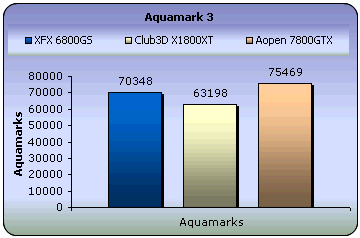
What can we say about this graph? We'll leave the comments up to you. All we can say is: nice!
3DMark 2001
 is the predecessor to 3DMark03. It's mainly a directx8.1 benchmark and the score depends a lot on the CPU power of your computer. However for reference use only we decided it'd be best to just leave it in our benchmark list so you can compare the next generation cards with the possibly outdated you have at home.
is the predecessor to 3DMark03. It's mainly a directx8.1 benchmark and the score depends a lot on the CPU power of your computer. However for reference use only we decided it'd be best to just leave it in our benchmark list so you can compare the next generation cards with the possibly outdated you have at home.
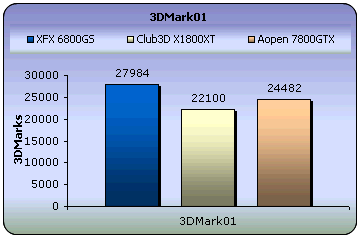
This does not make any sense. We could see on the screen when running the game tests, that the performance of the 6800GS XXX was lower than the other two cards, but the final score is higher. Maybe this is what happens when you mix old benchmarking software with brand new cards, or maybe this is a 3dMark bug. In any case, the final score does not represent the actual performance of the card.
9. Half Life 2

Half life 2 is no doubt the most anticipated pc game of all times.
 Characters - Advanced facial animation system delivers the most sophisticated in-game characters ever seen. With 40 distinct facial "muscles," human characters convey the full array of human emotion, and respond to the player with fluidity and intelligence.
Characters - Advanced facial animation system delivers the most sophisticated in-game characters ever seen. With 40 distinct facial "muscles," human characters convey the full array of human emotion, and respond to the player with fluidity and intelligence.
Physics - From pebbles to water to 2-ton trucks respond as expected, as they obey the laws of mass, friction, gravity, and buoyancy.
 Graphics
- Source's shader-based renderer, like the one used at Pixar to create movies
such as Toy Story® and Monster's, Inc.®, creates the most beautiful
and realistic environments ever seen in a video game.
Graphics
- Source's shader-based renderer, like the one used at Pixar to create movies
such as Toy Story® and Monster's, Inc.®, creates the most beautiful
and realistic environments ever seen in a video game.
AI - Neither friends nor enemies charge blindly into the fray. They can assess threats, navigate tricky terrain, and fashion weapons from whatever is at hand.
To measure performance we used the Video Stress Test(VST) that is available in the CounterStrike:Source beta available through Steam. We set all the details to the highest level and each time changed the resolution from 800x600 up to 1600x1200.
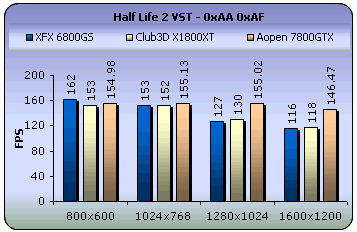
Since the game is very CPU dependent, it is better to ignore results taken at 800x600 and 1024x768 resolutions. The true value of a VGA card is best seen at higher resolutions with HL2. That is, at 1280x1024 and at 1600x1200 gaming resolutions. But again, while the 7800GTX card is alone at the top, the 6800GS battles it out with ATI's X1800XT once again.
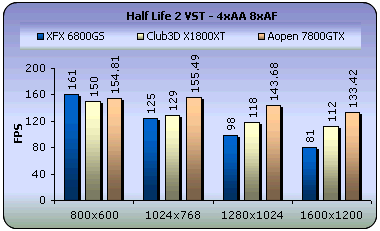
But with AA and AF enabled, when even more graphics processing power is needed, the X1800XT takes its revenge. The XFX 6800GS XXX Edition just could not keep up.
10. Far Cry

 You are Jack Carver running your own boat charter business in beautiful Micronesia. With a past best left behind you, you'll be focusing on your present assignment: escorting an ambitious journalist named Valerie Cortez to the Island of Cabatu. It seems like a piece of cake, but you'll soon learn: paradise can be hell.
You are Jack Carver running your own boat charter business in beautiful Micronesia. With a past best left behind you, you'll be focusing on your present assignment: escorting an ambitious journalist named Valerie Cortez to the Island of Cabatu. It seems like a piece of cake, but you'll soon learn: paradise can be hell.
Farcry is an awesome First Person Shooter (FPS) based on a last generation 3D engine named as CryEngine. Real-time editing, bump-mapping, static lights, network system, integrated physics system, shaders, shadows and a dynamic music system are just some of the state of-the-art features that the CryEngine offers.
A great advantage and strong point of the CryEngine is its physics system which supports character inverse kinematics, vehicles, rigid bodies, liquid, rag doll, cloth and body effects. All physics seem to be very realistic and you never get bored when facing enemies, since character models have multiple animations that blend in believable ways.
With an integrated shader system and a massive terrain which maximizes
the view distance to 2km, these features make Farcry a perfect action game and
also a referable benchmark to speak of.
- Benchmark Settings
For this game we recorded a custom demo from the start of the Rebellion
stage. We chose an indoor scene in order to avoid getting the CPU bound effect. This will result in slightly higher results since it is also less
GPU intensive, but we can't afford being stuck at 40-50 fps because of our CPU.

The latest patch (1.3) was used for our tests which updates the
game's graphics engine to use the 3.0 Shader model. This option is only supported
for nVidia's 6800 and 7800 series.

The resolutions we ran the demo under, are the following:
- 800x600
- 1024x768
- 1280x1024
- 1600x1200
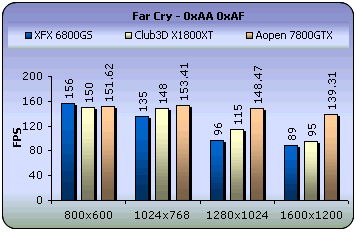
The use of the Shader 3.0 model is significant. As expected, the 7800GTX card was the best performing card, but the X1800XT that does not support the Shader 3.0 model, was slightly faster than the XFX 6800GS XXX card.
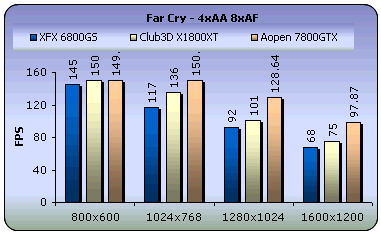
Nothing changes with AA and AF enabled.
11. Ground Control II
 Ground
Control 2 is an action-oriented game of tactics and warfare. As Captain Jacob
Angelus of the Northern Star Alliance, you will command squads of infantry,
artillery, and air power against the might of the Empire of Terra. Base building
and resource-collecting are replaced with unit control and combat tactics where
your knowledge of the battlefield maneuvers will make the difference in your
fight against a ruthless enemy. Position your troops on hilltops for better
aim or inside buildings and forests for protection as you'll need to use every
inch of terrain to your advantage.
Ground
Control 2 is an action-oriented game of tactics and warfare. As Captain Jacob
Angelus of the Northern Star Alliance, you will command squads of infantry,
artillery, and air power against the might of the Empire of Terra. Base building
and resource-collecting are replaced with unit control and combat tactics where
your knowledge of the battlefield maneuvers will make the difference in your
fight against a ruthless enemy. Position your troops on hilltops for better
aim or inside buildings and forests for protection as you'll need to use every
inch of terrain to your advantage.
For our benchmarks, we used the highest possible settings on the first mission
of the single player game and moved around the camera to get an average frame
rate using fraps.

Ground Control II offers really impressive graphics without requiring much GPU power. Click on the picture above to view a screenshot from the game. Check out these excellent water effects!
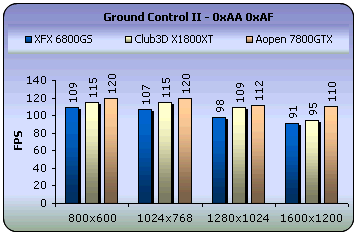
As with FarCry, nVidia chipsets seems to be working at full speed with these games.
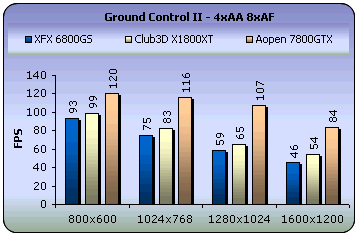
Same with AA and AF enabled. The 6800GS chipset performs a little faster than the 6800GT chipset.

12. Need For Speed - Most Wanted
 Wake up to the smell of burnt rubber as the thrill of illicit street racing permeates into the air.
Wake up to the smell of burnt rubber as the thrill of illicit street racing permeates into the air.
Combining illicit street racing and tuner customization with the intensity of strategic police pursuit that surpasses any Hollywood-style chase scene, Need for Speed Most Wanted will be on every gamer's 'must-have' list this holiday season. Out-race rivals, evade cops and exploit hundreds of miles of open road as gamers make their way up the Blacklist.
To become the most wanted racer, players must build up their street cred and Rap Sheet with gripping, white knuckle, head-to-head races with the top drivers on the streets, as well as pull daring, evasive moves to out-run and out-fox the cops that patrol the open road. Players can manage their heat or utilize a number of strategic tactics to keep the cops off their tails as they leave their rivals behind to suck their exhaust fumes.

- Benchmark Settings
NFS Most Wanted does not include a default benchmark. To measure the card's performance, we've chosen to record the framerate at the start of a circuit race with end-game cars. The starting point tends to be one of the most graphically demanding sections because of the smoke created by spinning wheels added to the rest of the game's visual effects. If a card can pass this stage with an acceptable framerate, it is a guarantee that it will face no problems with the rest of the game.

The resolutions we used are 800x600, 1024x768, 1280x1024 and 1600x1200. We measured performance at the lowest and highest possible settings.
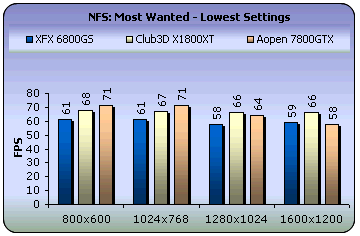
Need for Speed gave ATI a chance to take the lead. At low resolutions, using the lowest graphics settings, the 7800GTX was the best card, but as gaming resolutions were increased, no card could get above the Club3D X1800XT.
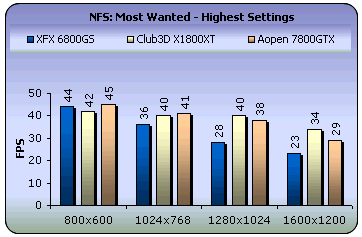
Same thing with the highest graphics settings, and this time, the difference between the 7800GTX and the 6800GS cards is more prominent. Again, the winner here is Club3D's X1800XT.

13. F.E.A.R.
 You aren't a soldier. You are a weapon. A paramilitary force infiltrates a multi billion dollar aerospace compound taking hostages, but issuing no demands.
You aren't a soldier. You are a weapon. A paramilitary force infiltrates a multi billion dollar aerospace compound taking hostages, but issuing no demands.
The government responds by sending in its best special operations teams, only to have them obliterated. Live footage of the massacre is cut short by an unexpected wave of destruction that leaves military leaders stunned and in disbelief.
First Encounter Assault Recon (F.E.A.R.) is one of the new-generation FPS. The graphics are really stunning, the plot behind the whole shooting successfully keeps it interesting and even the A.I. seems to work well.
F.E.A.R. offers a lot to the First Person Shooter world. The graphics are very clear with excellent textures, great new effects that will stress your graphics card and rag-doll physics that are waiting to be exploited as you progress through the game.
- Benchmark Settings
F.E.A.R. allows you test the video settings with a mini-benchmark involving a lot of weapon firing, explosions and several other effects. After the benchmark is run, you're presented with a screen showing your minimum, average and maximum framerates and also percentages of how often the framerate was below 25fps, between 25 and 40, and finally above 40. For presentation reasons, we're just sticking to the minimum and average framerates.

The resolutions we used are 800x600, 1024x768, 1280x1024 and 1600x1200. We measured performance with high and highest details.



The Club3D X1800XT seems to perform better with newer games. But again, although the 6800GS XXX card came last in this comparison, it gave its best and in the end, wasn't that far behind.
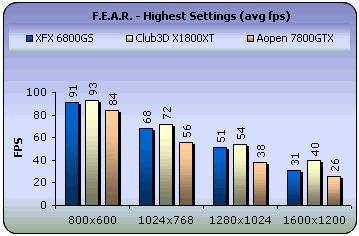


F.E.A.R. turns out to be a real headache for nVidia chipsets, while the ATI X1800XT gets first place at all game resolutions. It is really interesting to observe that the 6800GS XXX managed to climb above the 7800GTX card at higher resolutions. We ran the test two times to be sure about the results, but again the same fps values were reported. It is more probable to assume a driver limitation, rather than the 6800's supremacy over the 7800GTX.

14. Quake 4
 In a desperate war for Earth's survival, against an unrelenting alien enemy, the only way to defeat them is to become one of them. Armed with advanced weaponry and vehicles and aided by an elite squad of marines, you take the battle to the heart of the Strogg home planet and become Earth's only hope for victory.
In a desperate war for Earth's survival, against an unrelenting alien enemy, the only way to defeat them is to become one of them. Armed with advanced weaponry and vehicles and aided by an elite squad of marines, you take the battle to the heart of the Strogg home planet and become Earth's only hope for victory.
Quake 4 is a First Person Shooter developed by Ravensoft, based on the Doom 3 engine, and the graphics and gameplay certainly reflect that fact. For those who really hated the one-way corridors of Doom 3, new outdoor areas have been added to the game. The feeling however, still remains the same as these areas are quite small-scale, contrary to what other games have to offer.
- Benchmark Settings

As Quake 4 includes no default benchmark, we decided to go with another publicly available demo to measure performance. What we chose is a demo from HWSpirit, which involves a small outdoor scene followed by a long indoor combat. As preloading the stage once again failed miserably and the average framerate varied a lot, we ran it twice every time we restarted the game and measured only the second run.

The resolutions we used are 800x600, 1024x768, 1280x1024 and 1600x1200. We measured performance with and without Anti-aliasing.
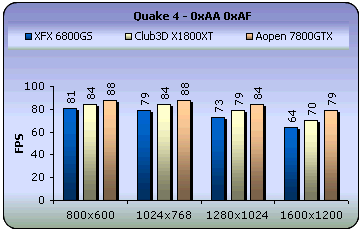
Quake4 uses the Doom3 engine, and since Doom3 likes nVidia cards, we expected to see the 7800GTX card in first place.

Things are a little different with AA and AF enabled. The X1800XT card showed its true value, right at the end of the test, with 1600x1200 resolution. In any case, the performance of the 6800GS XXX was more than we expected, since it performed slightly better than 6800Ultra series cards.

15. Overclocking
No matter your graphics card, there comes a time in your
computer's life when it can no longer cope with the latest technological
demands the ever so popular games impose. This is one of the main
reasons for overclocking your graphics card. Gamers are always looking forward
to
a
little extra
boost in terms of framerate. Even though most of the time the boost is far
from noticeable, overclocking remains the last resort when you can't afford
to buy a brand new VGA card.
The XFX 6800GS XXX comes already stock overclocked. The default running frequencies for the 6800GS card is 425MHz core clock and 500MHz memory clock. But the default core and memory clock for the XFX 6800GS XXX Edition are set to 485MHz and 1.10GHz respectively.

We ran some tests to see how far we can go with this card, and we managed to get a stable system running at 544MHz core clock and 1.22GHz memory clock. This might not seem like much, considering the default frequencies for this card (485MHz/1.10GHz), but they are when we look at nVidia's suggested clock frequencies.

During gaming, the card gave us only 57°C while overclocking with no artifacts or screen distortions of any kind, while when idle, the temperature level was 41°C. This means that you don't need to worry about temperatures when overclocking the XFX 6800GS XXX. The fan will do a great job when needed.

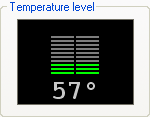
Let's see if we achieved a difference in performance.


We got a maximum difference of 7fps with FarCry and 9fps with Half Life 2, which is great.




16. Conclusion
 If you are a hardcore gamer and you always want to have the best VGA card available, well, the 6800GS is not for you. On the other hand, if you want to play all the games currently out there, but don't want to play them at the maximum resolution or with all the effects turned on, then this card might be a good choice for you. With all our tests completed, what are our final thoughts on the XFX 6800GS XXX Edition.
If you are a hardcore gamer and you always want to have the best VGA card available, well, the 6800GS is not for you. On the other hand, if you want to play all the games currently out there, but don't want to play them at the maximum resolution or with all the effects turned on, then this card might be a good choice for you. With all our tests completed, what are our final thoughts on the XFX 6800GS XXX Edition.
First of all, for all users that still have an AGP motherboard, the 6800GS and the 7800GS cards are an excellent choice. No other card supporting AGP, performs this well, while most manufacturers have moved over to PCI-E anyway. At the time of this review, the 7800GS cards had only been announced by nVidia and were not available on the market, so the 6800GS solution is the only solution for AGP.

The packaging was complete, but we have seen better. We expected to see Call of Duty 2 offered in the retail package, just as with the XFX 7800GT, but instead we had to settle for FarCry. However, this keeps the price of the card low enough to make it affordable for those that just don't want to spend a heap of money on a card, but still want to have good graphics performance.
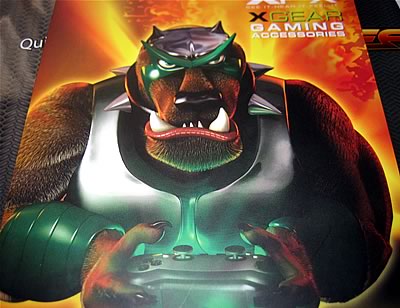
And performance we got. We were amazed with the results of our tests. Always keep in mind that this is not a high-end card, so don't expect to get performance as good as a 7800GTX or X1800XT.

The "XXX" in the card's name indicates that the card is already overclocked. But this doesn't mean you can't overclock the card further. The good thing is that you won't have any temperature problems since the stock cooler does a really nice job on the chipset. On the other hand, don't expect to transform this card into a 7800GT simply because you've overclocked it, but you can expect fair results.
The strong point of this card is its price. For about US$200, you get a good looking single slot card, that can play any game available, uses advanced chipset technologies and supports SLI (PCI-E version). The XFX 6800GS is the best card you can get for US$200. In our awards table below, if we could give more than five start in "value for money", we would.
Pros:
- Best performing mid-range card
- Supports SLI
- AGP and PCI-E editions
- Highest operating frequencies for 6800GS
- Single slot design
- Excellent price
Cons:
- Old game in the retail package (FarCry)

| Performance: |
 |
| Overclocking: |
 |
| Bundle: |
 |
| Value for money: |
 |